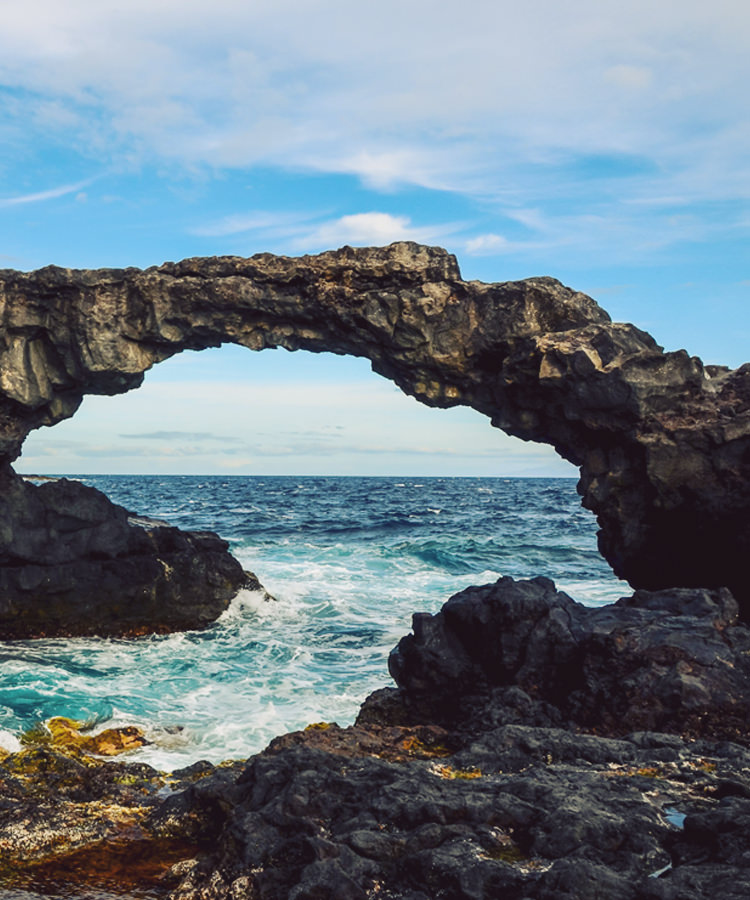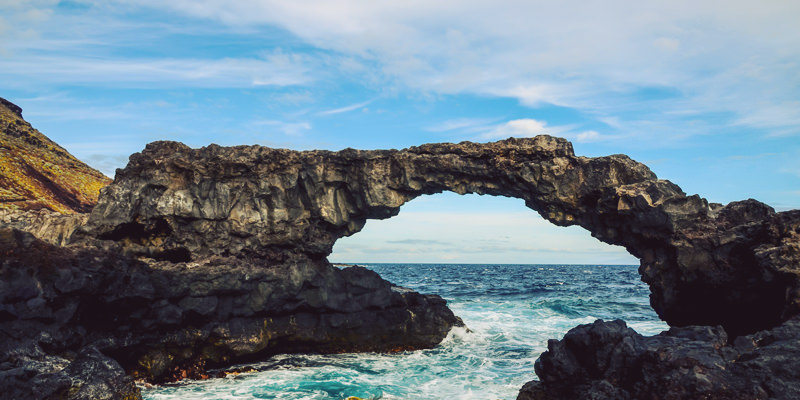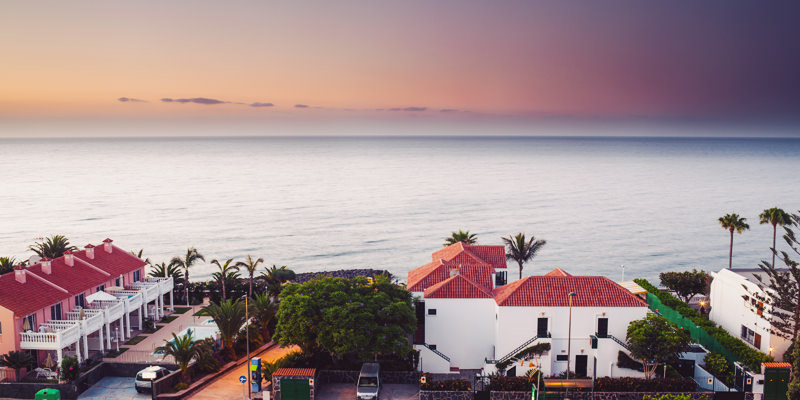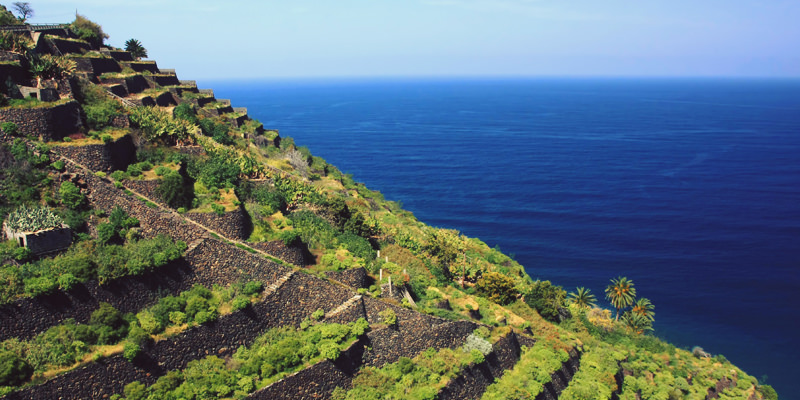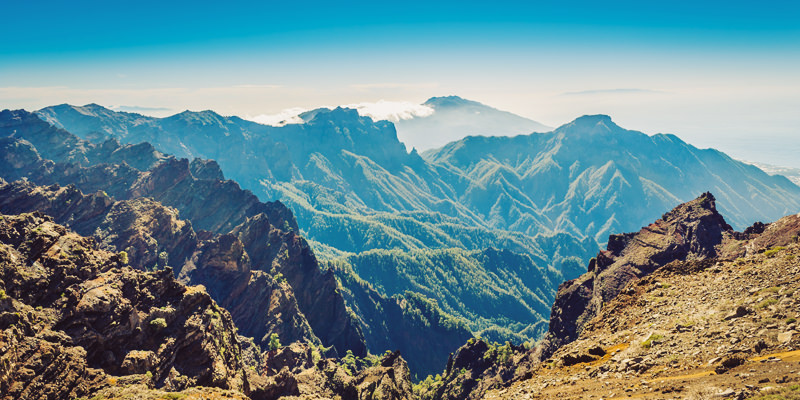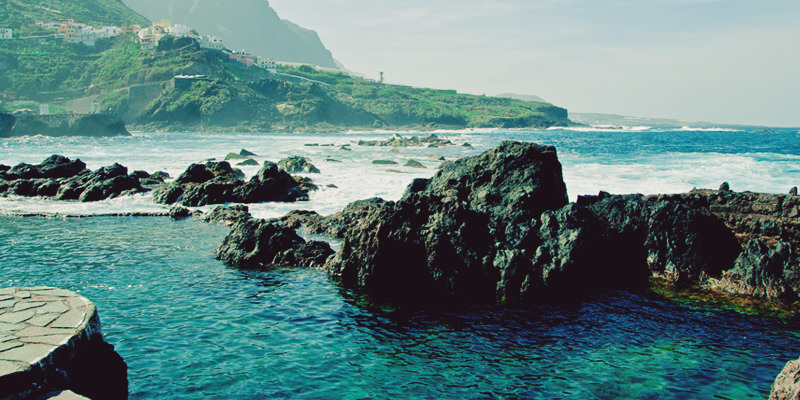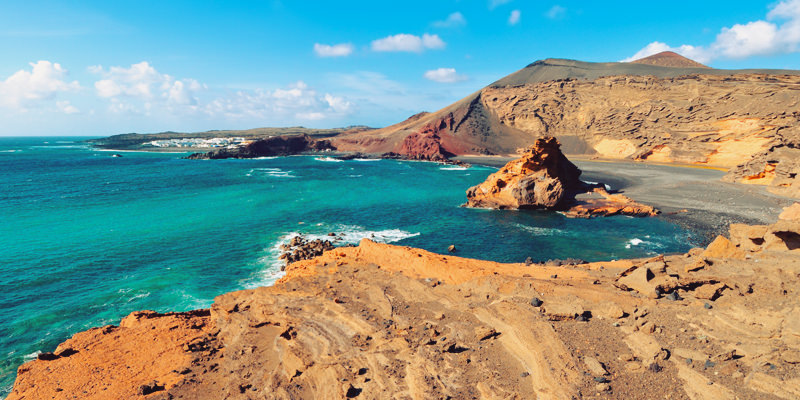To get to the most extreme winemaking region in Spain, you’ll have to travel a bit farther south than the country’s mainland – just off the coast of southern Morocco, to be exact. It’s here that the volcanic archipelago of the Canary Islands, or Las Canarias, sprung up over the course of several million years and became home to some of Europe’s oldest vines.
Located at a latitude of about 28 degrees, it seems improbable that the hot and humid Canary Islands could possibly produce quality wines; the vast majority of quality winemaking regions, after all, lie between 30 and 50 degrees latitude. Combined with rugged terrain, the potential for volcanic activity, and extreme winds, these conditions don’t exactly add up to the most ideal winemaking environment. But they do create one of the most exciting wine regions to emerge on an international stage in the past 10 years.
So what’s the deal with these extreme island wines? Here’s the 101 on the grapes, the wine styles, and the islands themselves. With such a recent modern wine emergence, the wines are only going to get better from here – and you’ll already be an expert.
The Wines
One of the assets that Canarian winemakers have is something that very few other regions can claim: extremely old vines. Because of the region’s isolation from the mainland, phylloxera never arrived in the Canary Islands, meaning that vines can quite literally be hundreds of years old – with hundreds of years of complexity.
Despite the hot climate, white grapes make up the majority of the Canary Islands’ wine production, both due to history and terroir. Like the island of Madeira, the Canary Islands were often a port for explorers sailing the world in the 1400s. At the time, Canarian winemakers favored the Malvasia grape, which was made into a sweet, syrupy wine very popular with foreign explorers and good for transport. Over time, however, sweet wines fell out of fashion, and modern tourism in the region provided a demand for dry, quaffable wines to be enjoyed beachside. Happily, the islands’ mineral-rich soil and mountain elevations lend themselves well to the production of dry, acid-driven whites.
Red and rosé wines are still made in the Canary Islands, with some islands focusing more on their production than others. Reds are often made in a fresh, easy-drinking style, vinified in stainless steel or using carbonic maceration, but some regions specialize in powerful, oak-aged versions as well. Despite lowered demand, the tradition of sweet winemaking is still alive, with some rich, fortified versions having considerable complexity and the ability to compete with the great sweet wines of the world.
The Grapes
While not altogether absent, international grape varieties are rarely seen in the Canary Islands. Rather, winemakers favor indigenous grapes that have been present for centuries (and often have more than one name), making the wines that much more interesting – and that much more confusing.
White grapes
Malvasia: An extremely important grape historically, Malvasia can make dry or sweet wines with plenty of aromatic intensity. Sweet, they tend to be honeyed and complex, while dry, they are typically clean and crisp but sometimes uninteresting.
Listan Blanco: Also known as Palomino, this grape is essential to the production of sherry. It is also very important to dry white wine production in the Canary Islands and expresses the minerality of the region’s terroir well.
Marmajuelo: Only found in the Canary Islands, Marmajuelo is only found in small quantities, as it can be difficult to grow. It is embraced, however, for its exotic fruit aromas and high acidity.
Other white grapes: Gual (a.k.a. Boal), Verdello (a.k.a. Verdelho), Forastera, Vijariego, Albillo, and more.
Red grapes
Listán Negro: The most widespread red grape in the Canary Islands, this variety is well suited to the light, fruity, Beaujolais-like style of wines made using carbonic maceration. While it is pretty much solely found in the Canary Islands and a bit of mainland Spain, it is genetically identical to the Mission grape first brought to the U.S. by Mexican settlers.
Negramoll: Also known as Tinta Negra, this grape is better known as being the workhorse grape of Madeira, despite the fact that there are far more plantings in the Canary Islands. It tends to produce easy-drinking wines that aren’t too tannic.
Other red grapes: Tintilla (a.k.a. Trousseau), Baboso (a.k.a. Alfrochiero), and more.
The Islands
Six of the Canary Islands produce wine: Tenerife, Lanzarote, Gran Canaria, La Palma, El Hierro, and La Gomera. For all except Tenerife, the DO zone of the region covers the entirety of the island. Each of the islands has its own unique features and techniques used to combat the region’s climactic challenges, but overall, a mountainous geography, elevated vineyards, and volcanic soil tend to define the Canary Islands’ terroir.
Tenerife
If you didn’t take a flight to the Canaries to drink Canary Island wines, there’s a good chance that the wine is from Tenerife. The largest of the archipelago’s islands, Tenerife is the only island with more than one DO zone. It is home to the majority of the region’s production, particularly for export. It is also home to Spain’s tallest mountain, Pico del Teide, which (surprise, surprise!) just so happens to be an active volcano. This volcano’s looming presence influences much of the geography of the island, and many of Tenerife’s vineyards are located on the fertile volcanic slopes of Pico del Teide.
Unlike the other islands, there is no DO Tenerife designation to cover the entire island. Rather, Tenerife is split into five tongue-twisting designations: Ycoden-Daute-Isora, Valle de la Orotaya, Tacoronte-Acentejo, Valle de Guimar, and Abona. Each has its own attributes, but white and red grapes grow throughout.
Lanzarote
While Tenerife may be the most available of the Canary Islands’ wines, Lanzarote certainly garners the most attention due to its one-of-a-kind vineyards. Historically an area based on agriculture, Lanzarote was forced to rethink things when, in the 1730s, a month-long volcanic eruption covered a third of the island’s land in volcanic ash. Few things would grow in this less- fertile soil, but fortunately, grapevines thrived.
Today, Lanzarote is known for its almost moon-like landscape: shallow holes dug into flat, black soil within which vines are grown, protected by a stone wall. This technique, also seen on the island of Santorini, is essential to protecting young vines from strong winds, which, while potentially destructive, help moderate Lanzarote’s desert climate. The wines are typically white, with lots of Malvasia grown here – the perfect refresher for those who venture out to visit Lanzarote’s vineyards on camelback.
Gran Canaria
The third largest of the islands, Gran Canaria is known for its wide range of mesoclimates, allowing it to make a variety of wine styles. Unlike most of the other islands, however, it is primarily known for its red wines, particularly its specialty, Tinto del Monte, a powerful red made from Listan Negro in the former DO of El Monte Lentiscal. Gran Canaria wines can be difficult to find outside Spain, but the wines of Frontón de Oro are exported readily to the U.S.
La Palma
A diamond-shaped island northwest of Tenerife, La Palma has quite an irregular topography, affecting the kinds of wines made in each sub-zone of the region. Unlike the other islands, La Palma has waterways running through it, allowing it to have a green countryside, particularly toward the northern part of the island. The red grape Negramoll is the most cultivated here and is used to make the local specialty vino de tea, a wine aged in pine barrels. Only a handful of wineries call La Palma home, and just one or two are exported, as other agriculture products like bananas and oranges dominate the landscape.
El Hierro
The tiny, westernmost island of El Hierro was home to only two wineries when the DO was founded in the mid-’90s. Today, there are still only a handful of producers, along with a local cooperative, so you’re unlikely to find any wines from El Hierro without traveling to the island itself. Though humid, a strong northwestern wind keeps the sloped and terraced vineyards from being too hot. White wines dominate, and the vines themselves can often be hundreds of years old, local varieties originally planted for distillation into spirits.
La Gomera
The Canaries’ newest DO covers the region’s second-smallest island, the circular La Gomera. Located just southwest of Tenerife, the terrain is extremely mountainous, and vineyards must be terraced along slopes and hand-harvested. These terraces, lined with stone walls to protect against strong winds, are a popular tourist destination on the island. La Gomera specializes in varietal white wines made from Forastera.
